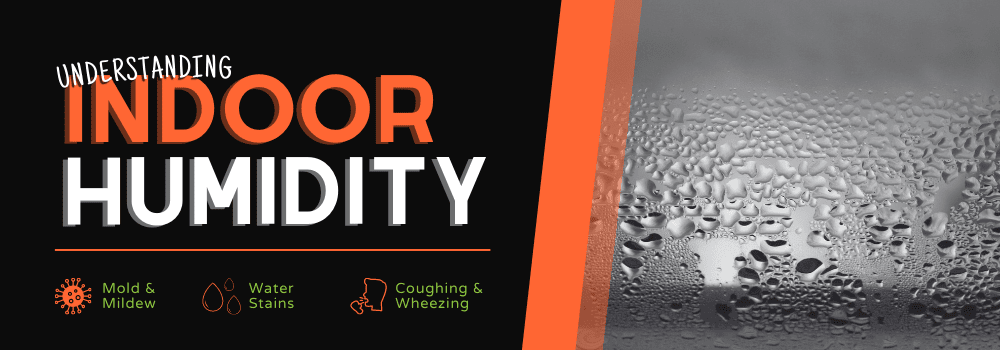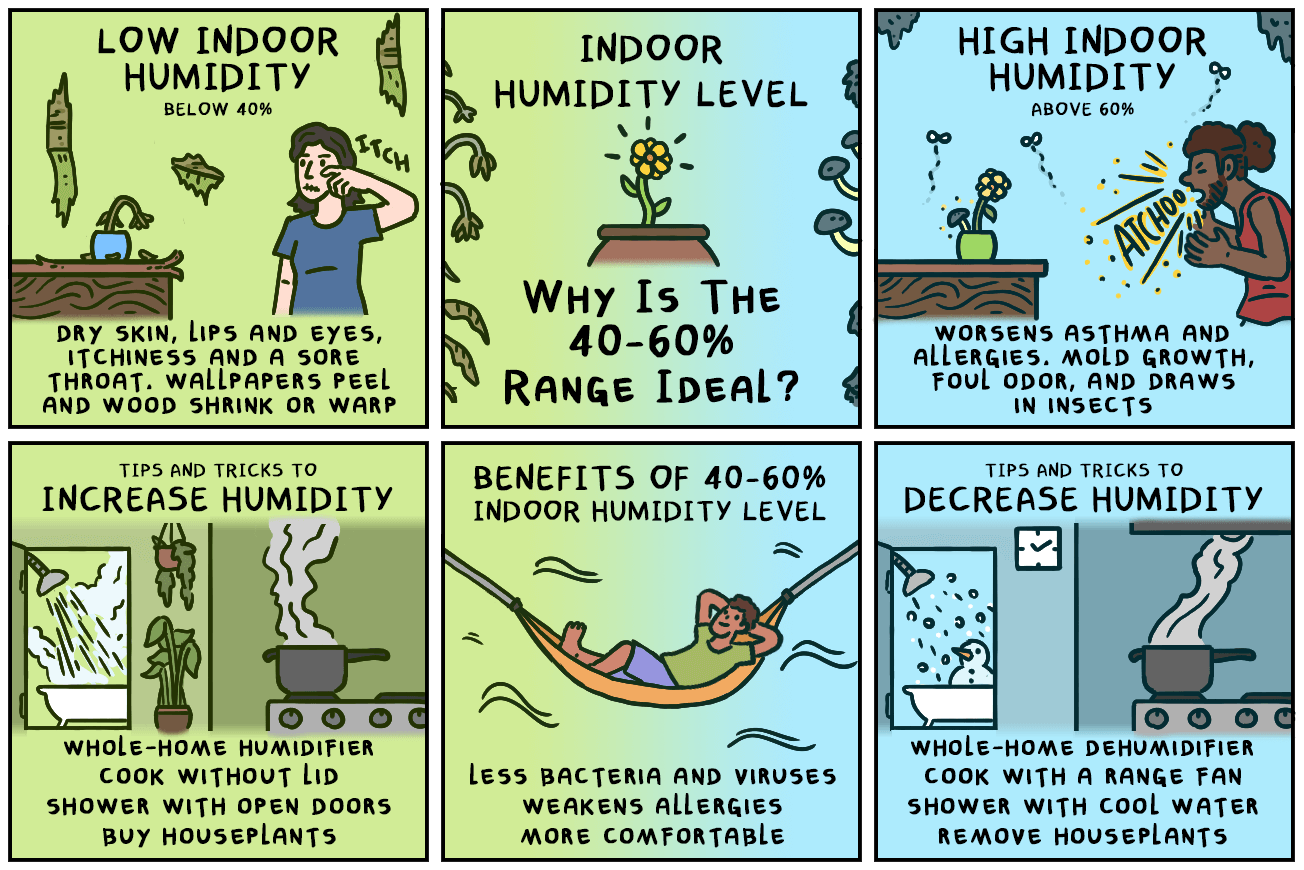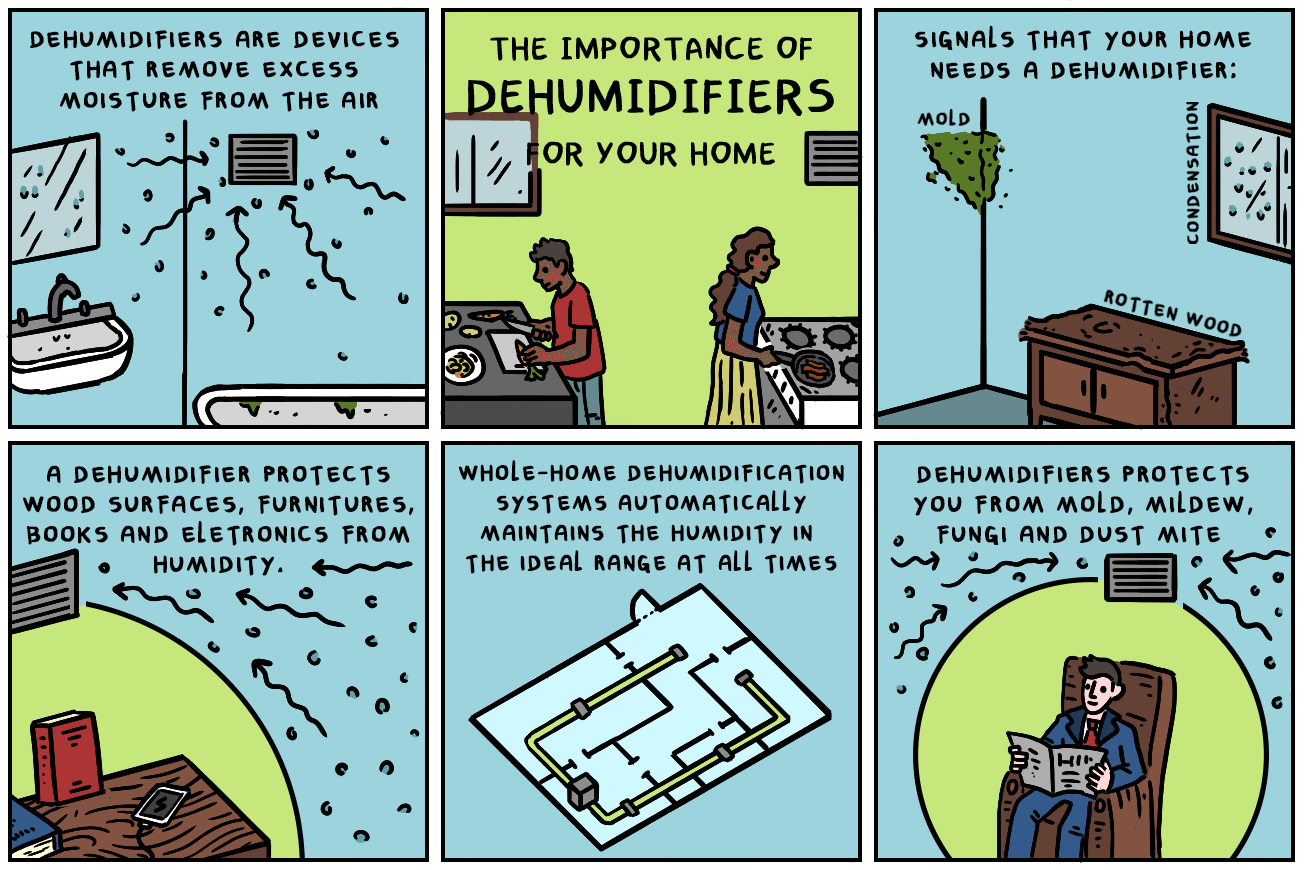Table of Contents
Why You Should Have a Home Humidity Control System
Let’s talk about indoor humidity, why you should control indoor levels and how to accomplish it. There’s an indoor humidity sweet spot, an ideal range to keep your home’s levels between, for improved indoor air quality. Luckily, there are whole-home solutions that will keep your home’s humidity in check year-round.

Understanding Humidity
Humidity is a measure of how much moisture is present in the air. High humidity levels result in a sticky-muggy-sweaty feeling, while low humidity levels cause uncomfortable dry air. Neither are desirable experiences—especially indoors! Controlling your home’s indoor humidity level is key to ensure a comfortable living space.
Indoor humidity isn’t just a comfort issue though. Humidity also has a huge impact on your and your family’s health and wellbeing.
And while humidity control is a less talked about indoor air quality solution, and often the last option homeowners consider for IAQ intervention; proper indoor humidity regulation has lasting benefits. Let’s break down whole-house humidity control.
What Is a Good Indoor Humidity Level?
To get technical … humidity is a measure of how much water vapor, AKA moisture, is in the air. Absolute humidity is the amount of moisture present at any temperature, while relative humidity is the amount of moisture in the air compared to the maximum amount of moisture possible at a specific temperature. Indoor humidity is a measure of relative humidity.
With those definitions in mind, what is actually a good indoor humidity level? Is there even a set standard or goal to reach for? Yes! A good indoor humidity level ranges between 40 and 60%. This mid-range is considered the sweet spot when it comes to indoor humidity.
 Ideal Indoor Humidity: Learn more about the ideal 40–60% indoor humidity range, as well as the tips and tricks available to control home humidity levels. Read more →
Ideal Indoor Humidity: Learn more about the ideal 40–60% indoor humidity range, as well as the tips and tricks available to control home humidity levels. Read more →

Dangers of Low and High Humidity
Low Humidity
Potential Health Effects
Noticeable symptoms and health conditions caused by low humidity levels include:
- Dry Skin, Itchy Skin & Rashes
- Chapped Lips
- Drier Sinuses (Drier sinuses make you more vulnerable to illness. How? It makes it harder for your nasal passage to ward off virus particles.)
- Itchy Eyes
- Chronic Bronchitis
- Nose Bleeds
- Increased Risk of Illness (As previously mentioned, a lack of moisture in the air means airborne particles will not drop as quickly and stay in circulation longer. This includes virus particles!)
 Virus Transmission & Humidity Control: The unexpected relationship between indoor humidity levels, infection trends, viral transmission, droplet size and healthy home IAQ is not only surprising to many but also confusing. Learn more →
Virus Transmission & Humidity Control: The unexpected relationship between indoor humidity levels, infection trends, viral transmission, droplet size and healthy home IAQ is not only surprising to many but also confusing. Learn more →
Potential Home Effects
- Dry air is particularly damaging to wood materials in the home. Dangers include cracks in wood floors, trim or window panes as well as damage to wood furnishings and finishes. Even wood-based musical instruments are at risk!
- Low indoor humidity levels can also cause walls and paint to crack or wallpaper to peel.
- While not necessarily a home quality issue, another clear sign that your space suffers from low humidity levels is an increase in static electricity.
High Humidity
Potential Health Effects
- Allergies
- Asthma (According to the EPA and the Berkeley Lab, it’s likely that one in five asthma cases is attributable to mold and excessive indoor moisture.)
- Difficulty Breathing
- Mild to Severe Headaches
- Coughing and Wheezing
- Trouble Sleeping
- Mold-Related Symptoms
Potential Home Effects
- High humidity levels can cause water stains on ceilings and walls, as well as discoloration, noticeable wet patches and paint bubbles.
- Mold isn’t only a health risk, it also has a significant home quality impact. Mold and mildew can cause a noticeable foul odor or musty smell. Noticeable mold growth is also possible—likely in black spots on walls and in corners.
- Higher indoor humidity allows rather unwelcome and unpleasant organisms to thrive. That is—dust mites. Most commonly found in bedding, carpets, and furniture, dust mites thrive in humid settings. They also contribute to respiratory-related symptoms.
- Excessive humidity levels can lead to rotting or warping home surfaces, furniture, and materials.
 All Things Mold: Certainly not the most appealing topic … but preventing mold and mildew growth and exposure indoors is key to a healthy home. More on how IAQ solutions and whole-home humidity control can help →
All Things Mold: Certainly not the most appealing topic … but preventing mold and mildew growth and exposure indoors is key to a healthy home. More on how IAQ solutions and whole-home humidity control can help →
Benefits of Home Humidity Control
Now, after listing the many risks and threats poor home humidity control causes, let’s focus on the benefits of proper indoor humidity regulation!
- Studies have shown that proper indoor humidity regulation leads to better sleep! Good indoor humidity can help reduce snoring and simply provides a more comfortable sleeping environment. Not only will you sleep better, but you’ll also wake up better. Good humidity levels get rid of common overnight symptoms like a scratchy throat and drier sinuses.
- Good indoor moisture also means moisturized skin, AKA healthier skin.
- Perhaps one of the biggest benefits of humidity control is the overall health and wellness benefits. How bacteria, germs, airborne viruses, and biological organisms (i.e. dust mites and mold spores) spread depends on indoor moisture levels. The ideal humidity environment, that 40 to 60% sweet spot reduces the risk of airborne illnesses, worsening respiratory conditions and the spread of bacteria and organisms. Extreme humidity levels, whether low or high, can both cause and worsen health conditions.
How to Control the Humidity in Your House
Controlling indoor humidity levels might seem improbable. Especially when you consider the sources of excessive or insufficient indoor moisture. A huge part of it depends on outdoor conditions, seasonal weather and your local climate. Other likely factors include the design and construction of your home, varying levels of airtightness and ventilation, and even daily activities and habits. All of this contributes to indoor humidity conditions!
And while your HVAC system plays a role in your home’s humidity, its purpose is not to humidify or dehumidify. The reality is, only dedicated humidity control solutions truly target and regulate indoor humidity levels.
The good news, though, is that there are several whole-home humidity control solutions available to choose from. Whatever concerns or issues you have with indoor moisture—low humidity, high humidity, or a bit of each depending on the season—there’s a useful IAQ solution for your space!
Whole-Home Humidity Control
We recommend opting for whole-home solutions over portable or single-room devices simply because they address the entire space. Standalone units can only humidify a single room at a time. And more than likely, if your home is suffering from humidity-related air quality issues, there’s a good chance it requires a widespread solution.
Another huge benefit of whole-home humidity control is that the devices are installed directly into your home’s existing HVAC system. Translation: the device monitors indoor relative humidity levels throughout the whole home and sends a signal when it detects levels outside of the desired range. It then automatically humidifies or dehumidifies your space.
For both humidification and dehumidification solutions, sizing the device is key. Available models range significantly in how many pints of water they add or remove from your home’s indoor air daily. Choosing a properly sized model will depend on the size of the space or square footage of your home.
It should also be said that the advantages of choosing a whole-home solution include less maintenance, particularly for humidifiers. With an in-duct system, there are no worries about proper water levels, changing the water, and routinely cleaning the system or worries about the water quality.
Whole-Home Humidification
A whole-home humidifier solution adds moisture to the air. There are two technology approaches to increasing home moisture levels:
Steam Humidifiers
A steam humidifier adds moisture to the air by releasing steam. The device has an internal reservoir where it heats water and converts it into steam. The steam is then circulated throughout your home using the furnace or blower and existing ductwork, successfully increasing the humidity level.
Evaporative Humidifiers
Evaporative humidifiers use a fan to pull air into the device where it passes through a moisture-saturated wick pad. The pad, or filter, remains wet thanks to an internal reservoir in the humidifier. Once the air passes through the filter, it flows back out into your home, increasing the humidity level.
 Whole-Home Humidifiers: Interested in learning more about the two systems? Check out our extensive guide comparing steam and evaporative models. Read our guide →
Whole-Home Humidifiers: Interested in learning more about the two systems? Check out our extensive guide comparing steam and evaporative models. Read our guide →

Whole-Home Dehumidification
A whole-home dehumidifier uses an internal system fan to pull air into the device and remove moisture. The device collects the water in an internal reservoir. This ensures that only drier air remains in circulation.
Certain dehumidifier solutions include additional IAQ features like room-by-room control options and the ability to control airflow into specific areas of the home.
Common Questions About Humidity Levels
To survive, mold requires two things: moisture and oxygen. Mold is a biological organism and a type of fungi that thrives in damp, moist, humid conditions. That is why high humidity levels enable mold growth.
Certain mold species can grow at a humidity level of 55%. But a better indoor humidity level average for mold growth is roughly 70% humidity. Depending on the temperature, anything higher than 65% indoor relative humidity provides ideal moisture conditions for mold.
Also important to note, the higher the relative humidity indoors, the quicker mold will form. Meaning, while there is some risk of mold growth at 60% relative humidity, it would take a significantly longer period (as in months, at a steady high humidity level) compared to higher humidity levels.
A few quick steps you can take to decrease humidity levels in your home include: showering with cold water, cooking with the range fan on and consider opening doors or windows when running the dryer. However, these are only short-term solutions. True in-the-moment quick fixes.
The better solution is to invest in a whole-home dehumidifier. Once installed, the device will automatically lower your home’s humidity levels when it detects increased moisture. Depending on the size of your home and the size of the device, it can take anywhere from minutes to hours to noticeably dehumidify your home.